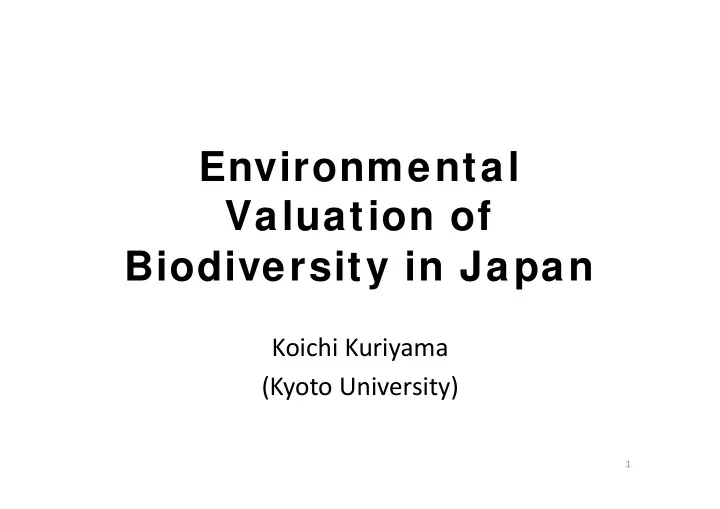

Environmental Valuation of Biodiversity in Japan Koichi Kuriyama (Kyoto University) 1
Introduction • Why Valuing Biodiversity? – No price of biodiversity • Economic Values of Biodiversity – Use-value and non-use value • Empirical Studies in Japan – Contingent valuation studies • Policy Implication – Economic incentives for conservation 2
Why Valuing Biodiversity? • Cost of biodiversity conservation – US$22 billion per year • Benefit of biodiversity conservation – No price – No profit to protect biodiversity • Problems of conservation – Cost benefit of conservation – Monetary benefit of conservation 3
Economic Values of Biodiversity Forest Values Use Value Non ‐ Use Value Direct Indirect Option Bequest Existence Use Value Use Value Value Value Value •Timber •Recreational •Conservation for •Conservation for •Conservation for production use future use future generation endangered •Landscape •Genetic •World heritage species resources •Wildlife habitat 4
Replacement Cost Forest Value of Japan Billion $ / year 36 11% Water conservation 69 21% Preventing landslides 65 20% Recreational use 6 2% Biodiversity and wildlife habitat 156 47% Cleaning air 332 100% Total value Source: Forestry Agency (1993) Note: Estimated by the replacement cost method, US$1 = 118 yen in 1993. 5
Valuation of Biodiversity • Characteristics of biodiversity value – No market price – No substitution goods – Non-use value • Contingent Valuation (CV) – How much to pay for biodiversity conservation? 6
Case Study Yakushima World Heritage Site • World Heritage List since 1993 • Yakusugi cedar • More than 1,000 years old • Biodiversity • More than 1,900 spiecies • Increasing tourists • Conflicts • Biodiversity conservation? • Tourism development? 7
Vegetation Distribution Altitude (m) Alpine plants 2000 1500 Yakusugi cedar 1000 Temperate evergreen 500 forests Tropical and Subtropical 8
CV Question (Biodiversity Protection Scenario) Landscape protection Biodiversity protection • Would you pay * * * yen for protecting biodiversity in Yakusima World Heritage site? 9
Double-bounded CV Follow-up WTP response interval Initial Upper bid Yes response $30 - Yes $30? Initial bid No $10 - $30 $10? Lower bid Yes $5 - $10 No $5? No $0 - $5 10
CV Question (Tourism Development Scenario) Landscape protection No Biodiversity protection • Would you pay * * * yen for protecting biodiversity in Yakusima World Heritage site? 11
Data • CV survey of Yakusima World Heritage Area – Double-bounded CV • Split-sample CV Scenario – Biodiversity conservation – Tourism development scenario • In-person interview survey – 821 sample – response rate 68.4% 12
Estimation of Willingness-to-Pay Prob. of YES Response 1.0 0.5 Median WTP Bid 0 13
Estimation Results WTP Aggregated Value Scenario (million dollar) ($ / household) Biodiversity 48.0 2,109 Conservation Tourism 29.2 1,283 Development 18.8 826 Difference Note: Market Value 1,461 million dollars 14
Valuation Function Scenario Valuation Targets Individual Attributes Landscape Ecosystem protection Important Age + - + Household Ecosystem - size + protection Value of + + Income Biodiversity Yakushima + scenario + Assessment Use Value TV program User Distance Option to Visit 15
Case Study Kabukuri Marsh • Kabukuri marsh • Rice paddies – Habitat for the wild goose – 423ha area was inscribed as a registered wetlands under the Ramsar Convention 16
Winter-Flooded Rice Paddies • Ramsar area • Including rice paddies • Management for w aterbirds habitat 17
Population of Wild Goose 10 years ago About 10,000 Current More than 70,000 18
Choice Experiment Plan 1 Plan 2 Plan 3 62ha 150ha 62ha Marsh 0ha 50ha 22ha Rice paddies Birdwatching Yes No No Site $10 $5 $0 Payment ↓ ↓ ↓ 1 2 3 19
Willingness-to-pay Yen per household per year Ecotourism Marsh Rice paddies Local Other 20
21 Eco Tourism WTP Distribution (Ecotourism)
WTP Distribution (Marsh Conservation) Eco Tourism Marsh 22
Summary • Need for valuing biodiversity – No market price of biodiversity – Market failure • Contingent valuation – How much to pay for conservation? • WTP of biodiversity – Ecotourism: Local resident – Ecosystem: National resident – Heterogeneity in preference of biodiversity 23
Policy Implication • Cost share of biodiversity conservation – Beneficiary pays principle – Payment scheme with heterogeneity • Conservation w ith private capital – Limits of government subsidies – Economic incentives to conserve biodiversity – Valuing biodiversity 24
Recommend
More recommend